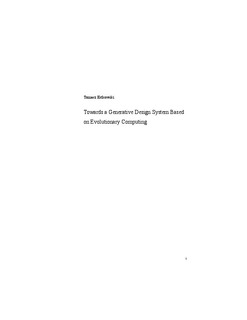Towards a generative design system based on evolutionary computing
Doctoral thesis, Peer reviewed

Åpne
Permanent lenke
http://hdl.handle.net/11250/195728Utgivelsesdato
2014-06-02Metadata
Vis full innførselSamlinger
- Design [33]
Sammendrag
This thesis proposes elements and principles for a digital generative design system, which involves Evolutionary Computing. The functioning of the system is based on an analogy between a design process and a process of natural evolution. The design system based on natural evolution seems especially appropriate in the early stage of a design process, where architects explore design possibilities by testing a number of different versions of design. Proposed generative design system is meant to support architects by generating different versions of building models, whose automatic development is guided by design objectives inputted by a system’s user.
Evolutionary Computation has been selected as the guiding programming approach for this project because of its high generative and creative potential, and its flexibility in terms of application. Another key framework of this thesis is sustainable architecture. Here, sustainable architecture is understood first as a balanced integrative approach, which intends to comprehend architecture in its totality (in contrast to other systems, which focus on one or two architectural features). This property of sustainable architecture makes it suitable as a default system of values, which sets an unbiased direction for automated design development. This thesis investigates four prototypes of a generative design system, concluding that they are fragmented. The main claim of the thesis is that a design system, in order to function, has to take into consideration a wide variety of design aspects (social, environment, economic), as defined in the guidelines of sustainable development. A practical application of the principles developed and discussed in this thesis may be a computer-based system or CAAD (Computer Aided Architectural Design) system. Such a system would function as a creative design assistant during the conceptual stages of architectural design. This thesis, however, does not provide an operative CAAD system, but just the theoretical ground for it.